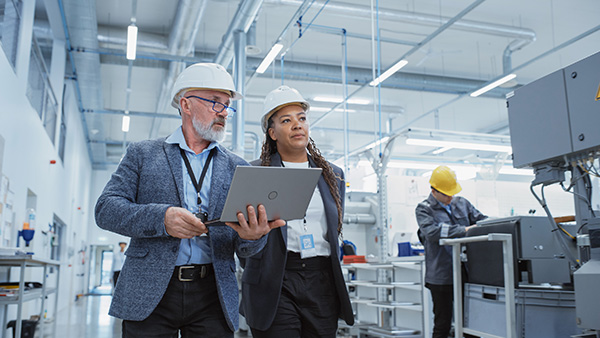Companies should invest in the digital employee experience (DEX) for better collaboration amongst their youngest generation of worker.
By Fernando Castanheira, CIO, Riverbed
In a digital-first, work-from-anywhere world, the tools employees use on a daily basis need to be achieving at peak performance. Recently for companies, this has been the reason their best talent stays or goes – which is a trend that’s sure to continue as AI-enabled tools enter the workforce. The bottom line: if leaders don’t give employees the digital tools they need to be successful, they will work for someone else. This has become especially true for the youngest generation of workers, who make up about 38% of the workforce, and soon to be 58% by 2030.
In manufacturing, this has an additional layer of complexity. For the software that guides metalworkers, heavy machinery and assembly, the margin for error or slowness is miniscule. This requires that every element in the technology stack is well-tuned and primed to lead to the highest productivity possible for workers. Any slowdowns or snags not only impact time-to-delivery but also affect the success of employees.
By investing in tools that improve the digital employee experience (DEX) and provide maximum visibility into the health of tech ecosystems, manufacturing leaders will be building the most efficient operations with the software and applications they already have at hand.

With so many soon-to-be manufacturers joining the workforce from Generation Z, it’s important for industry leaders to understand the priorities of the youngest segment of their teams. This is especially true of these youngsters who have always grown up around apps, SaaS and immediate returns – some call them “digital natives.”
For manufacturers who want to perform at maximum productivity, these employees need to have seamless online experiences when on the job. In fact, recent data showed that 72% of manufacturing business and IT decision makers believe Millennial and Gen Z employees would consider leaving a company with poor digital employee experiences. Further, 66% of the respondents said failing to meet the digital experience demands of younger generations would be disruptive to the business. Companies are finding that the younger generation of employees is much more demanding of the technology they need to drive bottom line success.
Perhaps adding even more pressure to the situation, much of the work that these younger workers are doing is remote – with more than a quarter of paid work in the United States remaining at least hybrid for the time being – making the need for close-to-perfect online experiences even more tantamount to employee success. For example, if a VPN is operating slowly because the server is overloaded, or a user is continually declining software updates, that can lead to increased frustrations and, ultimately, employees looking elsewhere for a better digital experience.
Fortunately, problems like slow VPNs and software can be resolved using DEX, allowing manufacturers to take a hard look at the wealth of user data available across their enterprise.
Manufacturing, for decades, has involved the same several legacy players, partners and software. When IT leaders think of digital transformation, it’s likely manufacturing isn’t the first sector that comes to mind. However, with the advent of generative AI, large-learning models (LLMs) and other data-driven software, the industry is now hot on the heels of the latest in technological advancement. According to recent EY data, nearly all (97%) of industrial manufacturing CEOs note that continuing digital transformation is either a very or fairly important near-term priority.
Understanding that legacy technology will be a part of a digitization strategy is important for manufacturing IT leaders to understand, before embarking on a DEX overhaul. In fact, by choosing a technology partner that can give them better insights into the historical performance of their software , these leaders might actually see the value in making incremental changes to their tech stack. This is why a comprehensive DEX approach is critical for evolving heavy industries.
DEX, at the core, is the collection of rich data based on how employees feel, react and respond to technologies implemented in the digital workspaces. By tracking and analyzing employees’ interactions with manufacturing software – whether through help desk ticketing or NPS scoring – IT leadership will be able to assess sentiment, scoring and other quantitative data, with the goal of making better software decisions in the future.
Manufacturing IT leaders will need to allocate resources to two important aspects of the DEX implementation: technology and people.
Large enterprises in manufacturing already have software in place for their processes. When looking to upgrade DEX, manufacturing leaders will need to prioritize software platforms that are easily implemented and integrate easily with other pre-existing tools. For example, if an autonomous laser is guided by digital templates, it’s important the template designing software is communicating with the software that guides the beam – and each application is as efficient as possible. Choosing a single provider that can manage the performance of all these applications and provide better visibility for manufacturing leads is a significant consideration for improving DEX.
On the human side of the upgrade, it’s important that manufacturing leaders create a small, but dedicated team to oversee DEX strategy. For enterprises with a large number of legacy customers, partners and vendors, this will also allow for smaller-scale experimentation too – before finance and provisioning teams start making changes to the entire technology ecosystem.
This team can be agile at the outset of the DEX improvement process, responding quickly to feedback and working together to guide observability tools that monitor the employee success. AI can also be instrumental for the DEX team, and to DEX in general, supporting help desk ticketing, alerts and even autonomous remediation without needing to bog down other teammates or leadership.
Strong DEX programs will lead to improved manufacturing technology overall because their goal is to make sure employees have the best possible tools for collaboration and productivity.
Companies are likely to see benefits in several aspects of the business after investing more heavily in their employees’ digital experiences, including employee wellbeing, productivity and company margins. Employee satisfaction, especially for those technologically-savvy millennials and Gen Z team members, is likely to increase – since employees have greater input on the software changes happening to their company.
Manufacturing leaders are also likely to notice a smoother, more productive go-to-market process. Improving DEX often minimizes technology problems and disruptions, leading to increased efficiencies from the design process all the way to production. Relatedly, company leadership may also experience cost reduction, since productivity has a direct impact on margins.
As the workforce gets younger and younger, it’s important for manufacturing leaders to meet these segments of the population with the tools that will lead to the best outcomes. Not only will teams feel better about the digital workspaces they use, manufacturing facilities will reap the rewards of a more plugged-in software ecosystem.

Fernando Castanheira is Riverbed’s Global CIO responsible for all aspects of IT including digital transformation, Cyber/IT security, infrastructure, operations and business platforms. In addition, Fernando leads the SaaS Business strategy function partnering with the customer facing teams on new approaches centered on providing ongoing customer value and delightful experiences. Prior to joining Riverbed, Fernando worked at JPMorgan Chase in various senior IT roles, most recently as a Managing Director and CTO.
Scott Ellyson, CEO of East West Manufacturing, brings decades of global manufacturing and supply chain leadership to the conversation. In this episode, he shares practical insights on scaling operations, navigating complexity, and building resilient manufacturing networks in an increasingly connected world.